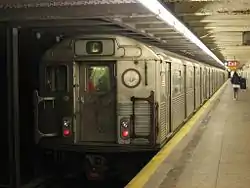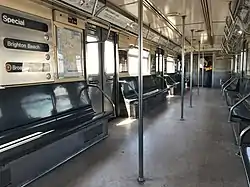R38 (New York City Subway car)
The R38 was a New York City Subway car model built by the St. Louis Car Company from 1966 to 1967 for the IND/BMT B Division.Two hundred were built in married pairs. The R38s were built to supply extra trains for service changes resulting from the 1967 opening of the Chrystie Street Connection. The R38 was the second subway car order to be built with stainless steel exteriors, after the R32, and the first subway car fleet to have air conditioning installed.
| R38 | |
|---|---|
 An R38 train on the C at Kingston–Throop Avenues | |
 Interior view of R38 car 4028 | |
| In service | 1966–2009 |
| Manufacturer | St. Louis Car Company |
| Built at | St. Louis, Missouri, USA |
| Replaced | Some remaining BMT Standards, and many were used for fleet expansion in anticipation of the 1967 Chrystie Street subway linking BMT with IND lines. |
| Constructed | 1966–1967 |
| Entered service | August 23, 1966 |
| Refurbished | 1987–1989 |
| Scrapped | 2008–2009 |
| Number built | 200 |
| Number preserved | 2 |
| Number scrapped | 198 |
| Formation | Married Pairs |
| Fleet numbers | 3950–4149 |
| Capacity | 50 (seated) |
| Operator(s) | New York City Subway |
| Specifications | |
| Car body construction | Stainless steel sides with carbon steel chassis, roof and underbody, with fiberglass top front and top rear bonnets. |
| Car length | 60 ft (18.29 m) |
| Width | 10 ft (3.05 m) |
| Height | 12.08 ft (3.68 m) |
| Platform height | 3.76 ft (1.15 m) |
| Doors | 8 sets of 45 inch wide side doors per car |
| Maximum speed | 55 mph (89 km/h) |
| Weight | 77,420 lb (35,117 kg) |
| Traction system | General Electric SCM 17KG192AE2/H7 propulsion system |
| Traction motors | General Electric 1257E1 |
| Power output | 115 hp (86 kW) per axle |
| Braking system(s) | Westinghouse Air Brake Company E2 "SMEE" Braking System, American Steel Foundries simplex unit cylinder clasp (tread) brake |
| Track gauge | 4 ft 8 1⁄2 in (1,435 mm) standard gauge |
The first R38s entered service on August 23, 1966. In 1987–1989, all R38s were rebuilt by General Electric, and the original rollsigns and express/local marker lights at the end of each car were replaced with flipdot signs. The R160 order replaced the entire fleet of R38s, the last of which ran on March 18, 2009. After retirement, all cars but one pair, which is preserved by the New York Transit Museum, were stripped and sunken as artificial reefs.
Description
The R38s were numbered 3950–4149. The cars were arranged in "married pairs" of two cars semi-permanently coupled together by a drawbar. Even-numbered cars were known as "B" cars, while odd-numbered cars were known as "A" cars.
The R38 was the second subway car order to be built with stainless steel exteriors, the first being the R32 order in 1964. The cars were built with aluminium roofs, vandal-proof fiberglass seats, and with indirect fluorescent lighting, which also provided illumination of the advertisement cards as well, a similar setup to the last 150 R32 cars delivered in 1965 numbered 3800–3949.[1]
The R38 was the first successful subway car fleet to have air conditioning installed after earlier prototypes failed on older subway cars. The last ten cars delivered (4140–4149) came factory equipped with Stone-Safety 10-ton split system air conditioning system featuring the compressor/condenser units mounted under the cars, while the evaporator units were installed on the top interior ends of the car in 1967.[2] The first six air conditioned cars came into service on the F train on July 19, 1967.[3] The six-week experiment was a success after past failures, and air conditioning would soon, but not immediately, become standard equipment on new rolling stock built for the system, since the first 200 R40 cars were built without air conditioning. The air conditioned cars cost $40,000 more than the non-air conditioned cars.[4] From this point on, the New York City Transit Authority began adopting air conditioning as standard equipment on all new cars, and older model cars were retrofitted with AC units to make life much more bearable throughout the subway system. The Stone-Safety Air Conditioning system was adopted from their standard railroad and commuter coach air conditioning systems, and it proved very successful.
History
In March 1965, the New York City Transit Authority, continuing its program of car replacement, ordered 200 additional cars for the B Division from the St. Louis Car Company.[5][6] These cars were the first to replace cars for the IND since it started operation in 1932. They also supplied extra trains for the Chrystie Street Connection, which opened on November 27, 1967. St. Louis was chosen after the first three bids were deemed as too high, with the cost savings totalling $500,000.[1]
The first two trains of R38s were placed in service at Queens Plaza after a brief introductory ceremony attended by Mayor John V. Lindsay, NYCTA Chairman Joseph O'Grady, and NYCTA Commissioners Joseph Gilhooly and Daniel T. Scannell on the E and F on August 23, 1966. Though there were controversies about diverting these cars from their original assignment for the D, it was decided to introduce the R38s on the IND Queens Boulevard Line, as the line was short of cars and the R1-R9s assigned to Jamaica Yard were in a bad state of disrepair.
Overhaul and mishaps
Cars 3990–3991 & 4000–4001 were involved in an incident on June 11, 1972, at the relay area east of the Jamaica–179 Street Terminal. These cars were stored in heavily damaged condition at Coney Island Yard until they were scrapped in 1983.[7][8][9]
In 1987–1989, the remaining R38s were rebuilt by General Electric at its Buffalo, New York facility. During the rebuilding process, the R38s were fully equipped with air conditioning systems. Prior to rebuilding, the R38s featured mylar curtain route signs on their bulkheads displaying the service bullet and destination, similar to past B-Division R-type cars. After rebuilding, they received Luminator flipdot signs that displayed the service letter only, since the air conditioning evaporators mounted on the interior car ends made it rather difficult to change the front route and destination rollsigns. The distinctive "EXP" (express) and "LOCAL" marker lights were also removed. Like the R32s, the rollsigns on the sides of the cars were updated and retained.
Retirement
.jpg.webp)
The R160 order replaced the entire fleet of R38s. The first cars were taken out of service in October 2008, and the fleet was gradually phased out until the last pair (4098–4099) made its final trip on the C on March 18, 2009. After retirement, almost all cars were stripped and sunken as artificial reefs.
Cars 4028–4029 are the only survivors and are preserved by the New York Transit Museum.[10] They were restored to operating status in 2013–2014 and have been operating on New York City Transit Museum-sponsored excursions since August 2014, specifically on the Train of Many Metals (TOMM).
In popular culture
The scene on a subway train in Coming to America was shot on an R38, prior to refurbishment.
The opening scene of the movie Saturday Night Fever shows a train of R38s on the B, also prior to refurbishment.[11]
The subway scene in the movie Ghost features an R38 train on the A, after refurbishment.
The trains in the video game Grand Theft Auto IV are based on the R38s.[12]
References
- Perlmutter, Emanuel (March 3, 1965). "200 cars on IND to be replaced; Cost Is Put at $22.5 Million -- Central Adds Units". New York Times. ISSN 0362-4331. Retrieved April 27, 2017.
- "Air-Conditioned Train To Get Subway Test". The New York Times. June 26, 1967. ISSN 0362-4331. Retrieved April 27, 2017.
- New York City Transit's Facts & Figures Celebrating 90 Years of Subway Service 1904–1994. New York City Transit. 1994. p. 3.
- Teltsch, Kathleen (September 5, 1967). "AIR-CONDITIONING A HIT ON SUBWAY; Riders Young and Old Find Coolness on the 'F' Train". The New York Times. ISSN 0362-4331. Retrieved April 27, 2017.
- NY orders 200 cars for subway Railway Age March 8, 1965 page 31
- Annual Report 1964–1965. New York City Transit Authority. 1965.
- "Showing Image 5027". nycsubway.org.
- "Showing Image 5028". nycsubway.org.
- "Showing Image 5029". nycsubway.org.
- "Showing Image 144513". nycsubway.org.
- skyMTV. "Saturday Night Fever (Opening Credits)". YouTube. Retrieved 17 August 2020.
- Guy, R62A. "GTA IV HD 60 FPS: Ridding all trains in Liberty City Subway System (Full Subway tour)". YouTube. Retrieved 17 August 2020.
Further reading
- Sansone, Gene. Evolution of New York City subways: An illustrated history of New York City's transit cars, 1867–1997. New York Transit Museum Press, New York, 1997 ISBN 978-0-9637492-8-4
External links
| Wikimedia Commons has media related to R38 (New York City Subway car). |